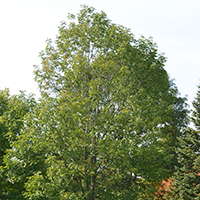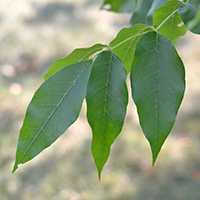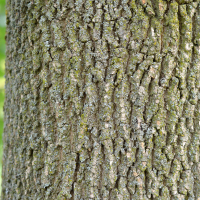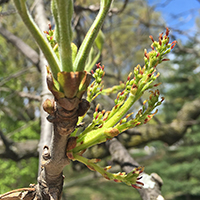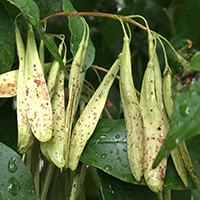What pumpkin ash looks like
Size and shape
- Reaches 30 metres high.
- Trunk up to 60 centimetres in diameter.
Leaves
- Glossy green and compound (up to 45 centimeters long).
- Have 5 to 9 leaflets (up to 25 centimetres each).
Bark
- Grey with interlocking ridges.
Flowers
- Green and purple flowers grow in clusters in spring.
Fruit
- Samaras (winged seeds).
- Up to 8 centimetres long, which is the largest of all our ash species.
Where pumpkin ash is found
Pumpkin ash is rare in Ontario and grows only in a few locations in Southern Ontario near lakes Erie and Ontario.
What you need to know to grow pumpkin ash
- Moisture: prefers wet soils.
- Soil: grows best in imperfectly drained soils.
- Shade: grows best in full sun.
- Caution: Emerald ash borer is an invasive insect that feeds on and kills ash trees. Signs of infection include wilted or yellow foliage, “D” shaped exit holes on tree bark, “S” shaped tunnels under the bark, and sawdust or frass in tunnels. Control measures for the emerald ash borer include insecticide injections and restricting the transport of infected ash supplies, like firewood, into non-infested areas.
Benefits and uses of pumpkin ash
Wildlife benefits
Pumpkin ash samaras are a food source for many birds and mammals, including:
- squirrels
- chipmunks
- wild turkey
- wood ducks
- chickadees
Pumpkin ash also provides nesting sites for birds and shelter for other wildlife.
Commercial uses
Pumpkin ash wood has been used for:
- flooring
- boxes and crates
- baseball bats
- hand tools
Pumpkin ash is highly susceptible to emerald ash borer and is not commonly planted.
Fun facts about pumpkin ash
- In very wet habitats, the bases of mature pumpkin ash trees will swell to resemble pumpkins.
Updated: November 22, 2023
Published: August 22, 2023
